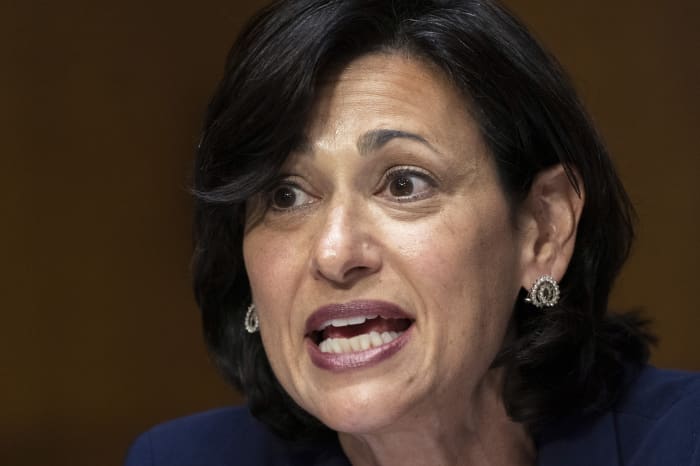The U.S. COVID-19 public health emergency comes to an end on Thursday, but the fight against COVID goes on — and some new challenges begin for those who hope to keep the virus at bay.
While the public health emergency, first declared in January 2020, officially expires at the end of the day on May 11, epidemiologists and public health experts emphasize that the virus isn’t going away. The end of the emergency will also usher in an era of higher COVID-testing costs for consumers and virus-tracking headaches for the government, as labs will no longer be required to report test results to federal officials.
Continued vigilance and a good dose of humility about our ability to predict what the virus will do next are required, epidemiologists say. “We need to continue looking both domestically and internationally to keep an eye on this and not assume that we know what’s going to happen,” said Justin Lessler, an epidemiology professor at the University of North Carolina’s Gillings School of Global Public Health. “It’s important that we don’t see the end of the emergency as the end of us fighting COVID.”
The U.S. is “now in a better place in our response than at any point of the pandemic and well-positioned to transition out of the emergency phase,” the Department of Health and Human Services said in a statement Tuesday, adding that more than 270 million people have had at least one shot of a COVID vaccine and more than 750 million free COVID tests have been shipped directly to more than 80 million households. COVID deaths have declined 95% since January 2021, HHS said, while hospitalizations are down nearly 91%.
The end of the U.S. public health emergency comes on the heels of the World Health Organization’s decision last week to end the COVID global health emergency and Centers for Disease Control and Prevention director Dr. Rochelle Walensky’s announcement the same day that she would leave the agency at the end of June. Shifting away from an emergency footing makes sense at this point, public health experts say, but doesn’t change the fact that the virus remains a major health threat. Globally, COVID is claiming a life every three minutes, “and that’s just the deaths we know about,” WHO Director-General Tedros Adhanom Ghebreyesus said at a press conference Friday.
More than 1.1 million people in the U.S. have died of COVID, and worldwide, the death toll is estimated to be at least 20 million. When the U.S. COVID public health emergency was declared on Jan. 31, 2020, there were just six cases in the U.S. The emergency declaration allowed the federal government to waive or adjust requirements affecting Medicare, Medicaid, private insurance and other areas, and several laws later added other provisions that were tied to the duration of the emergency.
Here’s what you need to know about the current state of COVID, how it might evolve and what the end of the public health emergency means for your healthcare costs.
Where is the virus heading?
Rates of COVID hospitalizations and deaths in the U.S. are approaching the lowest levels seen during the pandemic, according to CDC data. There were about 1,100 weekly COVID deaths as of May 3, according to the CDC, compared with more than 23,000 during the pandemic’s deadliest week in January 2021. The weekly number of new cases has also steadily declined this year, to about 77,000 as of May 3, according to the CDC, but that’s almost certainly a sharp undercount, said Dr. Rebecca Wurtz, an infectious-disease physician and associate professor at the University of Minnesota School of Public Health. “Most people are testing themselves at home and not reporting it,” she said.
The overall trends seem promising, but even if COVID deaths remain around 1,000 per week, the virus would still be more deadly than the flu in all but its very worst years, Lessler said. And he believes the COVID numbers may well tick up again and that the virus could cause 100,000 deaths a year in the U.S. for the foreseeable future.
There aren’t any new variants setting off major alarms at the moment, epidemiologists say, and some are looking for the virus to settle into a more predictable pattern, although that could take several years to play out. “My guess is that starting next year — or soon, at least — we’ll start seeing this look like a seasonal virus,” Lessler said. “It’s still one that’s going to be killing a lot more people than some of the other seasonal viruses we’re used to, like the flu.”
Others aren’t sure that such a predictable pattern is on the horizon. “We’re seeing a whack-a-mole virus,” Wurtz said. “It pops up in small ways, little outbreaks, little focuses of increased disease, that is very much unlike the flu.”
A year from now, Wurtz said, the virus could look much like it does today, as we “continue to have a low-level, consistent transmission. We may never move lower than this number of deaths.” What could change that, she said, is a higher rate of immunization.
What’s happening with boosters?
Everyone age 6 and older should get an updated Pfizer-BioNTech
BNTX,
As with flu shots, there’s an ongoing effort to match COVID shots with the strains that are circulating. A Food and Drug Administration advisory committee will meet June 15 to make recommendations on the strains that should be included in updated COVID shots for fall. Pharmaceutical companies such as Moderna
MRNA,
The end of the public health emergency generally won’t affect the accessibility and costs of COVID vaccines. As the supply of federally purchased vaccines is depleted, the shots will transition to the commercial market. Even after that happens, most forms of private health insurance are required to cover COVID shots from an in-network provider without a copay. People on original Medicare will also continue to have their shots covered under Part B, with no cost-sharing.
What about COVID tests and treatments?
Higher costs for COVID tests — both at-home tests and those performed by clinicians — may be one of the widest-ranging effects of the end of the public health emergency, affecting the timeliness of COVID diagnoses and efforts to prevent transmission, according to KFF, a health-policy nonprofit.
After Thursday, people with private insurance may face out-of-pocket costs for over-the-counter and laboratory COVID tests. People with original Medicare will still get provider-ordered PCR and antigen tests with no cost-sharing, but Medicare coverage of over-the-counter COVID tests ends with the expiration of the public health emergency.
In a recent analysis of COVID-testing costs, the Peterson Center on Healthcare and KFF found that the typical private-insurance payment for diagnostic-lab COVID tests is about $45, while the typical self-pay cash price at hospitals is $51 for an antigen test and $91 for a PCR test. At-home COVID-testing prices average $11 per test, the analysis found.
The end of the public health emergency generally won’t change how COVID treatments are covered. Any federally purchased doses of treatments, such as the antiviral Paxlovid, will remain free, regardless of insurance coverage, but out-of-pocket costs for treatments may change as federal supplies run out. For people who are uninsured, a federal program announced last month will maintain broad access to COVID vaccines and treatments as these products transition to the commercial market.
How will we track the virus in the future?
After Thursday, the federal government will no longer have the authority to require that labs report COVID-testing data, which will affect the reporting of negative test results and the government’s ability to calculate the percent positivity for COVID tests in some jurisdictions, according to the Department of Health and Human Services. Hospitals will still be required to report COVID data through April of next year, but that reporting will shift from daily to weekly, according to HHS.
The end of the public health emergency means that the “CDC will no longer be able to collect data and share information many Americans have come to expect,” Walensky, the outgoing CDC director, said at a congressional hearing last week. Certain data that help track health disparities along racial, ethnic and urban and rural lines, she added, will no longer be submitted to the CDC.
“We will make do,” Walensky said at the hearing. “However, this should worry us all, primarily because of what it says about the visibility we will have into the next outbreak.”
The CDC will still have access to more data than is currently collected for other respiratory illnesses and will continue to report data to understand COVID trends and inform the public health response, according to HHS.
Overall, “I would not give us a great grade” on preparedness to track the virus long-term, Lessler said. While there are newer, valuable tools like wastewater monitoring, he said, “it would be better if we established some longer-term systems for monitoring this virus, and frankly viral infections in general, that were a bit more robust.”







